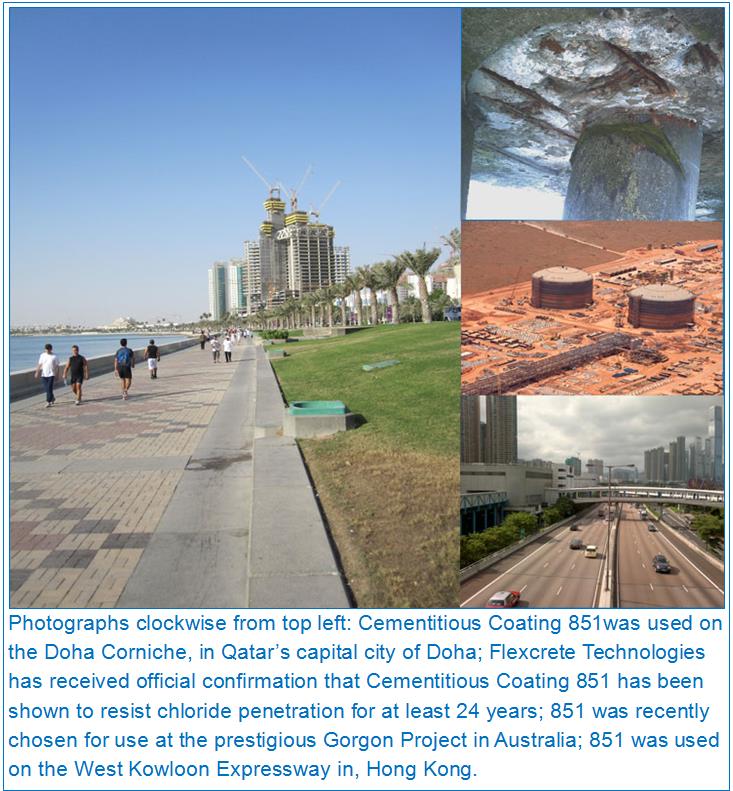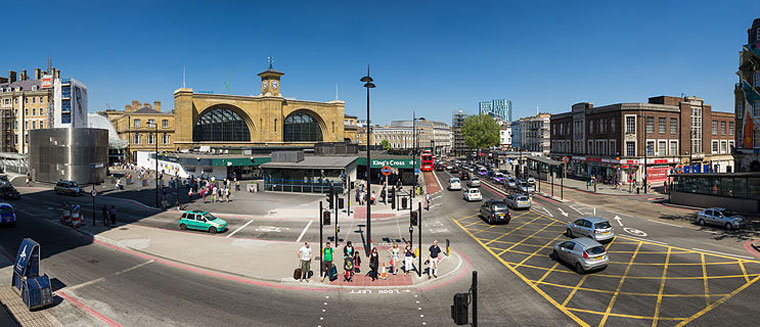When Cementitious Coating 851 was launched in 1985, it took the technology of polymer modified waterproofing slurries to new levels of performance and it would have been hard to imagine that nearly 30 years later they would not have been equalled, let alone bettered. The product has been used on prestigious construction projects all around the world to afford a cost-effective solution to complex problems and provide reinforced concrete structures with effective long-term protection against damaging elements to ensure their design life is achieved. It has been specified on both new and existing structures to reinstate concrete cover, waterproof concrete and provide an effective barrier to chloride ingress, amongst many other challenges typically encountered on infrastructure, civil engineering and building projects.
Cementitious Coating 851 is a highly advanced, two component, waterborne cementitious modified polymer coating which was formulated to minimise porosity and permeability and provide an effective barrier which not only protects concrete from the effects of aggressive acid gases, moisture and chlorides, but also has greatly enhanced chemical resistance. It forms a hard, highly alkaline coating for the protection and structural waterproofing of concrete, resisting positive and negative pressure under a 100 metre head, and is approved under Regulation 31(4)(a) for use in contact with drinking water.
851 provides an effective alternative to recasting or even demolition of precast and in-situ reinforced concrete, where the cover to the reinforcement has not been achieved to give the durability to attain the specified design life. A 2mm coating of Cementitious Coating 851 is equivalent to 100mm of good quality concrete, which will satisfy the most onerous design criteria. Being cement based, it chemically reacts with the substrate to form an integral part and will have a design life equivalent to that of the concrete to which it is applied. 851 can be applied to either green or aged concrete by brush or spray techniques, exhibits minimal hazard during application and is non-toxic when cured.
Chloride Attack Protection
Chloride attack is one of the primary causes of damage on reinforced concrete structures exposed to de-icing salts and harsh coastal environments and one of the key attributes of 851 is its ability to resist chloride ingress. Indeed, Flexcrete Technologies has received official confirmation that Cementitious Coating 851 has been shown to resist chloride penetration for at least 24 years.
In 1988, a 2mm thick film of Cementitious Coating 851 was applied to a concrete slice and sealed in a chloride ion diffusion cell in the laboratory at the VINCI Construction Technology Centre and it is still going strong some 24 years (8750 days) later. Tests recently carried out show that the barrier properties of 851 are such that a steady state of flux of chloride ions through the coated concrete has not been attained after a test period spanning 24 years, whereas the control concrete achieved this in just 28 days.
Although Flexcrete Technologies Limited is based in the UK, the company has a significant global presence with international agents and distributors in 65 countries worldwide, and there are many cases in action where Cementitious Coating 851 has been primarily specified to provide structural protection against chloride attack.
One such example is the Valle d’Aosta Bridges on the Milan-Turin Autostrada in Italy. Motorway bridges in this Alpine region are exposed to sub-zero temperatures and heavy snow each winter, needing liberal use of de-icing salts to keep them open. These salts, combined with frequent freeze/thaw cycling, are damaging to reinforced concrete structures and Cementitious Coating 851 was specified by the Italian Highways Authority for application to the bridges to provide effective waterproofing and resistance to cycles of freezing and thawing, whilst forming a barrier to both chlorides and carbon dioxide. Importantly for this project, 851 was able to be applied at temperatures as low as 5°C and it remains flexible to withstand thermal and structural movement without cracking or loss of adhesion.
Prestigious Gulf Projects
By the same token, Cementitious Coating 851 is also well proven in hot and humid climates, as demonstrated by two prestigious projects in the Persian Gulf – the Urea Prill Tower and Doha Corniche, both in Qatar’s capital city of Doha. The 65 metre tall reinforced concrete Urea Prill Tower is operated by the Qatar Fertiliser Company (QAFCO) and produces urea fertiliser 365 days a year. Constructed over 30 years ago, the Prill Tower is designed to allow liquid urea at 150°C to form into pellets as it drops through a counter-current of air. Elevated operating temperatures had weakened the concrete pore system and urea at high concentrations, mixing with washdown water, had formed crystals inside the open pores and cracks, further weakening the structure.
Inadequate reinforcement was first strengthened to prevent further cracking and, following a 12 month trial of four potential lining products, Cementitious Coating 851 was chosen not only because it had performed well but also ‘its mechanical characteristics were as close to the parent concrete as possible’ – a vital point for the specifying Engineers. The 851 exhibits a degree of flexibility and its abrasion, chemical and water resistance were also important factors in this project.
12 month trial of four potential lining products, Cementitious Coating 851 was chosen not only because it had performed well but also ‘its mechanical characteristics were as close to the parent concrete as possible’ – a vital point for the specifying Engineers. The 851 exhibits a degree of flexibility and its abrasion, chemical and water resistance were also important factors in this project.
Doha Corniche is a waterfront promenade extending for 10km along Doha Bay. Formed following extensive dredging work carried out during the late 1970s and early 1980s which reshaped Doha’s coastline, the Corniche is now popular among walkers, bikers and joggers. Protection from high seas is provided by a concrete breakwater which suffers from erosion from wave action and chloride induced corrosion of the steel reinforcement. When a new 500 metre precast concrete extension was constructed, the use of a chloride barrier was stipulated to extend the design life. Following consideration of a number of coating systems and intense testing, guided by Halcrow International and Partners, the Ministry of Municipal Affairs and Agriculture (MMAA) specified a 2mm layer of Cementitious Coating 851. Applied in just two coats by spray equipment and bonding intimately to the concrete, Cementitious Coating 851 provided a durable waterproof layer which will not break down under the harsh direct sunlight.
New Construction Projects
Indeed, Cementitious Coating 851 has been used to reinstate effective concrete cover on many new construction projects, one pioneering example being the West Kowloon Expressway in Hong Kong. Originally opened to traffic in 1997, this four kilometre highway runs from Kwai Chung Viaduct to the Western Harbour Crossing toll plaza, carrying traffic out to Hong Kong International Airport. Whilst the southern section is at ground level, the northern section is carried on a viaduct which is constructed from precast concrete segments. During construction, low cover was detected on a number of segments, requiring an innovative engineering solution.
Cementitious Coating 851 was approved by the Highways Department of the Government of Hong Kong as an economic and practical solution to enhance effective cover to reinforcing steel. The contractor cleverly blended white and grey grades of Cementitious Coating 851 to provide a colour matched solution which could be used in discreet patches.
More recently, 851 was chosen for use at one of the world’s largest natural gas projects – the prestigious Gorgon Project in Australia to enhance the effective cover on concrete caissons that form the base of the heavy lift Material Offloading Facility. Unprecedented in complexity, scale and engineering excellence, the Gorgon Project involves the development of the Gorgon and Jansz-lo gas fields about 80 miles off the coast of Western Australia and includes the construction of a huge Liquefied Natural Gas (LNG) plant on Barrow Island, as well as a domestic gas plant with the capacity to provide 300 terajoules per day to supply gas to Western Australia.
Cementitious Coating 851 was chosen for application to the caissons on the basis of its proven ability to provide reinstatement of effective cover on reinforced concrete, enhancing durability to achieve specified design life. As Barrow Island is a ‘Class A Nature Reserve’, it was important that all products provided were environmentally friendly and this could be assured with Cementitious Coating 851 as it is water-based with ultra-low VOC levels. International accreditation of materials was also important and this could be demonstrated with 851’s British Board of Agrément (BBA) approval and certification to EN 1504, the pan European standard for concrete repair. The works were carried out under rigorous quality controls by staff trained on-site by Flexcrete authorised representatives.
Designers and Engineers have also specified Cementitious Coating 851 to increase durability on new construction. For example, when a link bridge was constructed at Belvedere Riverside Energy from Waste (EFW) facility in South East London, the consultants, Royal Haskoning specified 851 as part of the design to protect the structure from chloride ingress, thereby ensuring the design life of the structure was achieved. Enhancement of 35mm cover to 91 precast beams was required and a 2mm coating of 851 ensured the structure was a barrier to both chloride and water ingress. In order to blend in, the colour of 851 was matched to that of the parent concrete.
Versatile Concrete
Cementitious Coating 851 is a highly versatile coating and this can be demonstrated by a recent project at London’s King’s Cross Railway Station, where 851 was specified for the waterproofing of plant room concrete roofs. King’s Cross Station handles some 47 million passengers a year and in preparation for the London 2012 Olympics, over £400 million was allocated for a major upgrade of the station, the first phase of which included the return of the neglected Grade One listed Eastern Range Building to its former glory, bringing back into use 70,000ft² of commercial office space for 400 staff. The Eastern Range ensured that the entire station remained operational during the construction works by allowing station staff to decant from areas of the station under construction.
Located under the original roof, newly constructed plant rooms required a permanent waterproofing system and Cementitious Coating 851 was used in conjunction with various other Flexcrete products. This was a green concrete application and after pouring the slab, it was left to cure overnight before preparing with a stiff brush and thorough soaking. To prevent outgassing, Cemprotec EF Primer was applied, a fillet was installed around the perimeter with Fastfill rapid setting repair mortar and Cementitious Coating 851 was laid at 2mm thickness. Cemprotec EF Grit was cast into the surface to give a slip resistant finish. Within the space of just four days, the slab was cast and waterproofing completed in record time, with heavy machinery installed just a few days later.
In summary, Cementitious Coating 851 has stood the test of time in demanding projects across the globe, providing effective protection on new construction, floors and trafficked areas and highway, coastal and water structures. 851 is the ideal protective coating for extending the design life of reinforced concrete structures and providing excellent protection against attack from chlorides, chemicals, acid gases and moisture.



